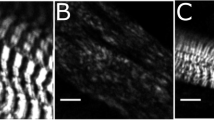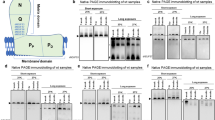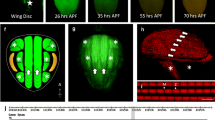Abstract
The similarity of amino acid sequence and motifs of the N-terminal extensions of certain class II myosin light chains, found throughout the animal kingdom, suggest a common functional role. One possible role of the N-terminal extension is to enhance oscillatory work and power production in striated muscles that normally operate in an oscillatory mode. We conducted small-angle X-ray diffraction experiments and small-length-perturbation analysis to examine the structural and functional consequences of deleting the N-terminal extension of the myosin regulatory light chain (RLC) in Drosophila flight muscle. The in vivo lattice spacing of dorsal longitudinal muscle (DLM) of flies lacking the RLC N-terminal extension (Dmlc2 Δ2–46) was ∼1 nm less than that of wild type (48.56 ± 0.02 nm). The myofilament lattice of detergent-treated, demembranated DLM swelled, with the Dmlc2 Δ2–46 lattice expanding more than wild type and requiring roughly twice the concentration of Dextran T500 to restore its lattice to in vivo spacing (9–10% vs. 4% w/v). The calcium sensitivity and maximum amplitude of net oscillatory work near the in vivo lattice spacing was significantly lower in Dmlc2 Δ2–46 compared to wild type (pCa50 shifted by approximately one-third of a pCa unit; amplitude reduced by approximately one-half). These changes were in contrast to the lack of effect reported in a previous study carried out in the absence of Dextran T500. The results are consistent with the N-terminal extension interacting with actin to increase the probability that crossbridges form during stretch-activated oscillatory work and power production, especially at submaximal levels of calcium activation.
Similar content being viewed by others
References
Andreev OA, Saraswat LD, Lowey S, Slaughter C and Borejdo J (1999) Interaction of the N-terminus of chicken skeletal essential light chain 1 with F-actin. Biochemistry 38: 2480–2485.
Andrews MAW, Maughan DW, Nosek TM and Godt RE (1991) Ion-specific and general ionic effects on contraction of skinned fast-twitch skeletal muscle from the rabbit. J Gen Physiol 98: 1105–1125.
Anson M, Drummond DR, Geeves MA, Hennessey ES, Ritchie MD and Sparrow JC (1995) Actomyosin kinetics and in vitro motility of wild-type Drosophila actin and the effects of two mutations in the Act88F Gene. Biophys J 68: 1991–2003.
Bhandari DG, Levine BA, Trayer IP and Yeadon MC (1986) 1HNMR study of mobility and conformational constraints within the proline-rich N-terminal of the LC1 alkali light chain of skeletal myosin. Correlation with similar segments in other protein systems. Eur J Biochem 160: 349–356.
Brenner B, Yu LC and Chalovich JM (1991) Parallel inhibition of active force and relaxed fiber stiffness in skeletal muscle by caldesmon: implications for the pathway to force generation. Proc Natl Acad Sci USA 88: 739–5743.
Brenner B, Xu S, Chalovich JM and Yu LC (1996) Radial equilibrium lengths of actomyosin cross-bridges in muscle. Biophys J 71: 2751–2758.
Dickinson MH, Hyatt CJ, Lehmann F-O, Moore JR, Reedy MC, Simcox A, Tohtong R, Vigoreaux JO, Yamashita H and Maughan DW (1997) Phosphorylation-dependent power output of transgenic flies: an integrated study. Biophys J 73: 3122–3134.
Fewell JG, Hewett TE, Sanbe A, Klevitsky R, Hayes E, Warshaw D, Maughan D and Robbins J (1998) Functional signi.cance of cardiac myosin essential light chain isoform switching in transgenic mice. J Clin Invest 101: 2630–2639.
Granzier HL and Wang K (1993) Interplay between passive tension and strong and weak binding cross-bridges in insect indirect flight muscle. A functional dissection by gelsolin-mediated thin filament removal. J Gen Physiol 101(2): 235–270.
Godt RE and Maughan DW (1977) Swelling of skinned muscle fibers of the frog: experimental results. Biophys J 19: 103–116.
Hammersley AP (1998) FIT2D V9.129 Reference Manual, ESRF Internal Report. ESRF98HA01T.
Hill TL, Eisenberg E and Greene L (1980) Theoretical model for the cooperative equilibrium binding of myosin subfragment 1 to the actin-troponin-tropomyosin complex. Proc Natl Acad Sci USA 77: 3186–3190.
Irving TC and Millman B (1989) Changes in thick filament structure during compression of the filament lattice in vertebrate striated muscle. J Muscle Res Cell Motil 10: 385–396.
Irving TC and Millman BM (1992) The Z-line/I-band and A-band lattices of intact vertebrate striated muscle at altered interfilament spacing. J Muscle Res Cell Motil 13: 100–105.
Irving TC and Maughan DW (2000) In vivo X-ray diffraction of indirect flight muscle from Drosophila melanogaster. Biophys J 78: 2511–2515.
Lowey S, Waller GS and Trybus KM (1993) Function of skeletal muscle myosin heavy and light chain isoforms by an in vitro motility assay. J Biol Chem 268: 20414–20418.
Maughan D, Moore J, Vigoreaux J, Blanchard E and Mulieri L (1998) Work production and work absorption in muscle strips from vertebrate cardiac and insect flight muscle fibers. In: Sugi H and Pollack G (eds) Mechanism of Work Production and Work Absorption in Muscle (pp. 471–480) Plenum Publishing Press, New York.
Millman BM (1998) The filament lattice of striated muscle. Physiol Rev 78: 359–391.
Millman BM and Nickel BG (1980) Electrosatic forces in muscle and cylindrical gel systems. Biophys J 32: 49–63.
Millman BM and Irving TC (1988) Filament lattice of frog striated muscle: radial forces, lattice stability and filament compression in the A-band of relaxed and rigor muscle. Biophys J 54: 437–447.
Moore JR, Dickinson MH, Vigoreaux JE and Maughan D (2000) The effect of removing the N-terminal extension of the Drosophila myosin regulatory light chain upon flight ability and the contractile dynamics of indirect flight muscle. Biophys J 78: 1431–1440.
Morano M, Zacharzowski U, Maier M, Lange PE, Alexi-Meskishvili V and Haase H (1996) Regulation of human heart contractility by essential myosin light chain isoforms. J Clin Invest 98: 467–473.
Parker VP, Falkenthal S and Davidson N (1985) Characterization of the myosin light-chain-2 gene of Drosophila melanogaster. Mol Cell Biol 5: 3058–3068.
Prince HP, Trayer HR, Henry GD, Trayer IP, Dalgarno DC, Levine BA, Cary PD and Turner C (1981) Proton nuclear-magnetic-resonance spectroscopy of myosin subfragment 1 isoenzymes. Eur J Biochem 121: 213–219.
Rarick H, Opgenorth T, von Geldern T, Wu-Wong J and Solaro R (1996) An essential myosin light chain peptide induces supra-maximal stimulation of cardiac myofibrillar ATPase activity. J Biol Chem 271(43): 27,039–27,043.
Schaub M, Hefti M, Zuellig R and Morano I (1998) Modulation of contractility in human cardiac hypertrophy by myosin essential light chain isoforms. Cardiovasc Res 37: 381–404.
Sutoh K (1982) Identification of myosin binding sites on the actin sequence. Am Chem Soc 21: 3654–3661.
Sweeney HL (1995) Function of the N-terminus of the myosin essential light chain of vertebrate striated muscle. Biophys J 68: 112s–119s.
Trayer IP, Trayer HR and Levine BA (1987) Evidence that the Nterminal region of A1-light chain of myosin interacts directly with the C-terminal region of actin: a proton magnetic resonance study. Eur J Biochem 164: 259–266.
Warmke J, Yamakawa M, Molloy JE, Falkenthal S and Maughan DW (1992) A myosin light chain-2 mutation affects flight, wing beat frequency and indirect flight muscle contraction kinetics in Drosophila. J Cell Biol 119: 1523–1536.
Yu LC, Steven AC, Naylor GR, Gamble RC and Podolsky RJ (1985) Distribution of mass in relaxed frog skeletal muscle and its redistribution upon activation. Biophys J 47: 311–321.
Vink H (1971) Precision measurements of osmotic pressure in concentrated polymer solution. Eur Polymer J 7: 1411–1419.
Author information
Authors and Affiliations
Rights and permissions
About this article
Cite this article
Irving, T., Bhattacharya, S., Tesic, I. et al. Changes in myofibrillar structure and function produced by N-terminal deletion of the regulatory light chain in Drosophila . J Muscle Res Cell Motil 22, 675–683 (2001). https://doi.org/10.1023/A:1016336024366
Issue Date:
DOI: https://doi.org/10.1023/A:1016336024366




